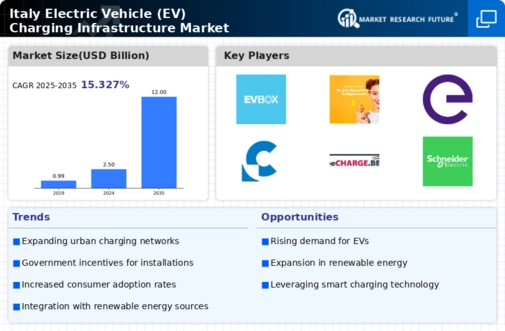Government Incentives and Policies
The Global Italy Electric Vehicle EV Charging Infrastructure Market Industry benefits significantly from robust government incentives and policies aimed at promoting electric vehicle adoption. The Italian government has implemented various subsidies and tax breaks for both consumers and businesses investing in EV charging infrastructure. These initiatives not only lower the financial barriers for consumers but also encourage private sector investment in charging stations. As a result, the market is projected to reach 1.5 USD Billion in 2024, reflecting a growing commitment to sustainable transportation. Such policies are likely to enhance the overall infrastructure, making EVs more accessible to the general public.
Rising Demand for Electric Vehicles
The increasing demand for electric vehicles in Italy is a pivotal driver for the Global Italy Electric Vehicle EV Charging Infrastructure Market Industry. As consumers become more environmentally conscious, the shift towards electric mobility accelerates. This trend is supported by the European Union's stringent emissions regulations, which compel automakers to produce more electric models. Consequently, the market is expected to expand significantly, with projections indicating a growth to 12 USD Billion by 2035. This surge in EV sales necessitates a corresponding increase in charging infrastructure, thereby creating a symbiotic relationship between vehicle sales and charging station availability.
Urbanization and Infrastructure Development
Urbanization trends in Italy are significantly influencing the Global Italy Electric Vehicle EV Charging Infrastructure Market Industry. As cities expand and populations grow, the demand for efficient transportation solutions increases. Urban areas are increasingly integrating EV charging stations into their infrastructure plans, recognizing the need for sustainable mobility options. This urban development is expected to facilitate the installation of more charging points, thereby enhancing accessibility for electric vehicle users. The alignment of urban planning with EV infrastructure development is crucial for meeting the anticipated market growth, which is projected to reach 12 USD Billion by 2035.
Technological Advancements in Charging Solutions
Technological innovations in charging solutions are transforming the Global Italy Electric Vehicle EV Charging Infrastructure Market Industry. Developments such as ultra-fast charging stations and smart grid technology enhance the efficiency and convenience of charging processes. These advancements not only reduce charging times but also improve the overall user experience, making electric vehicles more appealing to potential buyers. As technology continues to evolve, the market is likely to witness a compound annual growth rate of 20.81% from 2025 to 2035. This growth trajectory indicates a strong future for charging infrastructure, driven by ongoing improvements in technology.
Environmental Awareness and Sustainability Initiatives
Growing environmental awareness among consumers is a key driver of the Global Italy Electric Vehicle EV Charging Infrastructure Market Industry. As public concern over climate change and pollution rises, more individuals are opting for electric vehicles as a sustainable alternative to traditional combustion engines. This shift is supported by various sustainability initiatives from both governmental and non-governmental organizations, promoting the benefits of electric mobility. The increasing adoption of electric vehicles is likely to spur the demand for charging infrastructure, contributing to the market's projected growth to 1.5 USD Billion in 2024 and beyond.
























Leave a Comment